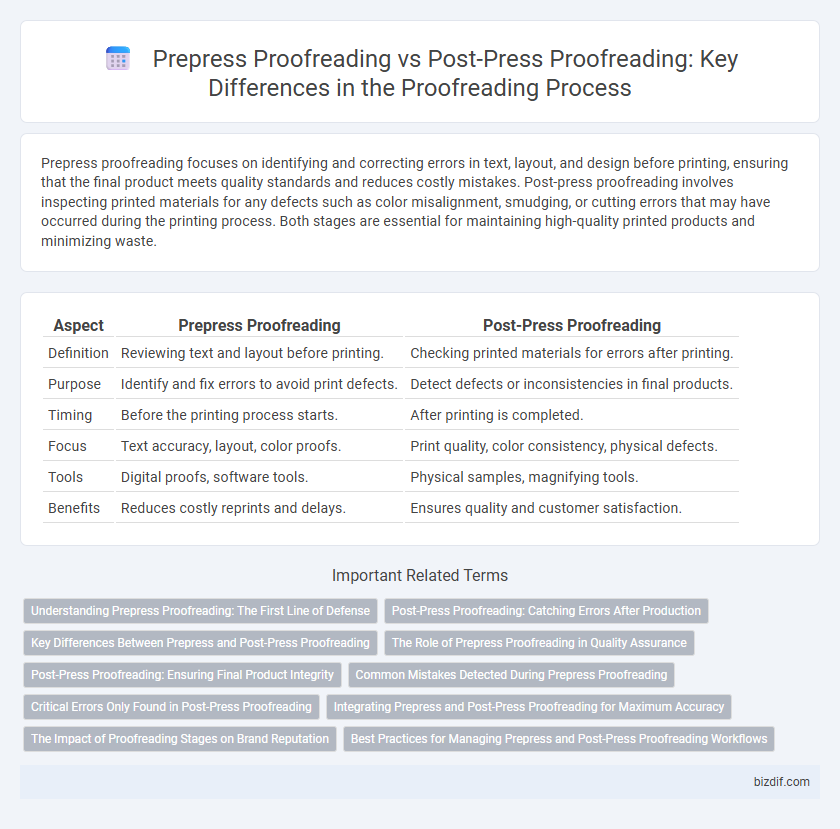Prepress proofreading focuses on identifying and correcting errors in text, layout, and design before printing, ensuring that the final product meets quality standards and reduces costly mistakes. Post-press proofreading involves inspecting printed materials for any defects such as color misalignment, smudging, or cutting errors that may have occurred during the printing process. Both stages are essential for maintaining high-quality printed products and minimizing waste.
Table of Comparison
| Aspect | Prepress Proofreading | Post-Press Proofreading |
|---|---|---|
| Definition | Reviewing text and layout before printing. | Checking printed materials for errors after printing. |
| Purpose | Identify and fix errors to avoid print defects. | Detect defects or inconsistencies in final products. |
| Timing | Before the printing process starts. | After printing is completed. |
| Focus | Text accuracy, layout, color proofs. | Print quality, color consistency, physical defects. |
| Tools | Digital proofs, software tools. | Physical samples, magnifying tools. |
| Benefits | Reduces costly reprints and delays. | Ensures quality and customer satisfaction. |
Understanding Prepress Proofreading: The First Line of Defense
Prepress proofreading acts as the first line of defense by identifying errors in text, layout, and color accuracy before the printing process starts, ensuring that the final output meets design specifications. This stage focuses on catching typographical mistakes, font inconsistencies, and image resolution issues that could lead to costly reprints if overlooked. Effective prepress proofreading minimizes production errors and maintains print quality standards by addressing problems early in the workflow.
Post-Press Proofreading: Catching Errors After Production
Post-press proofreading involves meticulously examining printed materials to identify errors that occurred during the production process, such as misalignments, color inconsistencies, and text distortions. This phase ensures that final products meet quality standards and reduces costly reprints by catching defects that prepress checks might miss. Focusing on post-press proofreading enhances overall print accuracy and customer satisfaction by validating the integrity of the finished work.
Key Differences Between Prepress and Post-Press Proofreading
Prepress proofreading involves reviewing design files and proofs before printing to catch errors in text, layout, and color accuracy, ensuring the final printed material meets quality standards. Post-press proofreading occurs after printing, focusing on identifying defects such as color misregistration, paper damage, or binding issues that affect the finished product's appearance. Key differences emphasize timing and focus: prepress targets digital content accuracy, while post-press addresses physical defects in printed materials.
The Role of Prepress Proofreading in Quality Assurance
Prepress proofreading ensures error-free content before printing, catching typographical, layout, and color issues early in the production process. This step reduces costly mistakes by verifying text accuracy and design consistency, enhancing overall print quality. Implementing rigorous prepress proofreading protocols significantly improves quality assurance outcomes in publishing and manufacturing workflows.
Post-Press Proofreading: Ensuring Final Product Integrity
Post-press proofreading is critical for verifying the final printed product's accuracy, checking for defects such as color inconsistencies, registration errors, and finishing flaws that may have been missed during prepress. This stage ensures that the physical output matches the approved digital proofs, safeguarding brand integrity and customer satisfaction. Effective post-press quality control reduces costly reprints and maintains high production standards.
Common Mistakes Detected During Prepress Proofreading
Prepress proofreading commonly detects errors such as typos, incorrect fonts, color inconsistencies, and layout misalignments before printing. It also identifies issues with image resolution, missing elements, and incorrect text placement that can affect the final product's quality. Catching these mistakes early in the prepress stage reduces costly reprints and ensures the accuracy of printed materials.
Critical Errors Only Found in Post-Press Proofreading
Critical errors only found in post-press proofreading typically involve issues such as color discrepancies, registration problems, and binding defects that are undetectable during prepress stages. These errors can affect the visual quality and functionality of the final printed product, often requiring costly reprints or adjustments. Post-press proofreading ensures the final output matches design specifications and production standards, safeguarding brand integrity and minimizing waste.
Integrating Prepress and Post-Press Proofreading for Maximum Accuracy
Integrating prepress and post-press proofreading ensures maximum accuracy by combining detailed content checks before printing with physical inspection of the final product for errors such as color shifts or misalignments. Prepress proofreading focuses on verifying text, layout, and graphics digitally, reducing costly mistakes early in the production process. Post-press proofreading validates the tangible output, catching issues that digital reviews might miss, creating a comprehensive quality control system.
The Impact of Proofreading Stages on Brand Reputation
Prepress proofreading ensures brand consistency and accuracy before production, preventing costly errors and maintaining a professional image. Post-press proofreading, although useful for identifying issues in final prints, risks brand reputation by allowing errors to reach the market and customers. Timely prepress proofreading minimizes reprints and customer dissatisfaction, safeguarding the brand's credibility and trustworthiness.
Best Practices for Managing Prepress and Post-Press Proofreading Workflows
Effective management of prepress proofreading workflows involves thorough verification of text, layout, and design elements before production to prevent costly errors. Post-press proofreading focuses on inspecting printed materials for color accuracy, registration, and physical defects to ensure final quality standards. Implementing standardized checklists, clear communication channels between design and production teams, and digital proofing tools enhances accuracy and efficiency across both stages.
prepress proofreading vs post-press proofreading Infographic

 bizdif.com
bizdif.com